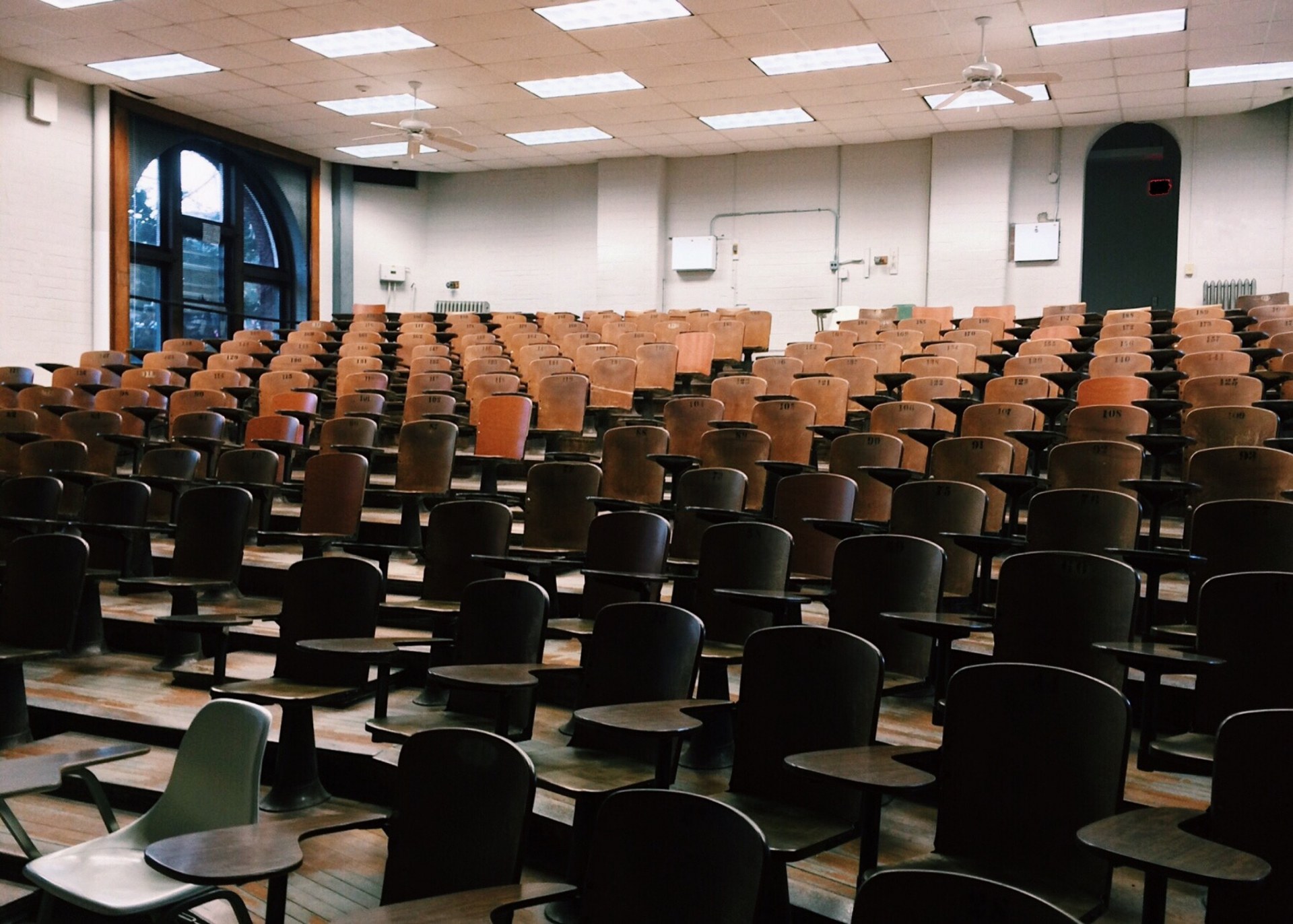
Lecture halls may be the one performance venue where the importance of speech intelligibility stands high above that of other types of venues. The speaker isn’t simply telling jokes, singing songs, or acting out scenes. In a lecture hall, the speaker is often teaching the youth and preparing them for their futures. It’s easy to see why lecture hall acoustic design is so incredibly important.
If you want to create a better sounding lecture hall, attention to acoustical detail is absolutely necessary. Lecture halls can get loud and echoey if not treated. Let’s look at some of the characteristics that make lecture halls unique audio atmospheres and how to treat them for great sound.
What is a Lecture Hall?
It may come as no surprise that a lecture hall is a large room designed to seat a large number of students while an expert of some sort lectures from the front of the room. It may be an industry professional or keynote speaker, but most often, it’s a college professor. If you’ve got a loud auditorium, lectures can be hard to hear.
Not only does the size and shape of the room affect how well the lecturer is heard, but the fact that the room is filled with numerous young people shifting and typing and chewing gum and chatting can add a significant amount of noise to contend with. A solid lecture hall audio system can help, but it sometimes just adds to the noise in the room.
Luckily, there are things that can be done to make your lecture hall sound great, and you don’t even have to be a psychoacoustics expert to make it happen.
Solving Problems with Lecture Hall Acoustic Design
When it comes to acoustics, lecture halls present a unique challenge. The space is usually fairly large, with a high ceiling and seating for a few dozen to a few hundred. This type of space is prone to some common audio issues if it isn’t acoustically treated.
Reverberation
Reverberation, or reverb, occurs when sound waves travel long distances and bounce around the room for too long before dissipating or becoming absorbed by softer materials. As these sound waves hang around, they produce an ambient sound that grows louder as more and more sound waves are added into the equation.
Large spaces with smooth, reflective surfaces tend to experience high levels of reverberation. Most sound waves get reflected, and the long distance they travel before impacting the next surface leads to a loud room. High ceilings compound the issue as well. Since that large open space often has no soft surfaces to absorb sound waves, they create an environment ripe for reverberation.
Addressing these waves in your lecture hall acoustic design is a must if you want to retain speech intelligibility and allow students to focus on the lesson.
Echo
Another issue common in large rooms is echo. Echo is similar to reverberation in that it’s caused by reflected sound waves bouncing back into the room. On the other hand, echo can create distinct waves that repeat sounds, making it harder to decipher what it is that the speaker is saying.
Since echo is caused by those large flat surfaces that reflect sound waves so well, you can significantly reduce echo with bread and butter treatments like diffusers and acoustical panels. A good lecture hall acoustic design should easily take care of any echo issues.
Lecture Hall Acoustic Design Basics
The audio issues that go hand-in-hand with large open spaces can surely cause issues when it comes to our ability to concentrate and hear lessons clearly. But that doesn’t mean we can’t significantly reduce or eliminate them with proper acoustical treatments. Let’s look at some attractive, highly effective means of tackling these audio issues.
Fabric Wrapped Acoustical Panels
The first step to any acoustic treatment is adding soft, absorptive materials, and lecture hall acoustic design is no different. By introducing softer surfaces, we allow a good deal of the sound waves that would otherwise be reflected back into the room the chance to be absorbed instead. They won’t absorb the very low bass frequencies, but those aren’t typically associated with human voices giving speeches and are rarely the most pressing issue you’re tackling.
By reducing the amount of reflected sound waves in the room, we can address echo and reverb at the same time. Any soft, absorbent material will absorb some of those sounds, but the acoustical materials in fabric wrapped acoustical panels allow them to outperform nearly anything else on the market.
Lots of people picture the egg crate style panels when they hear the term, but fabric wrapped acoustical panels are on another level completely. They are available in nearly any color you can think of, and if that isn’t enough, they can be printed with whatever artwork you like. That means your sound treatments can hide in plain sight, disguised as fine art or school insignia, or anything else you can dream up.
Microperforated Panels
If your lecture hall acoustic design aesthetic calls for a cleaner look without anything on the walls, microperforated panels are another great option to consider. They are available in all kinds of finishes, from wood to metal, to all the colors of the rainbow, so you can use them for nearly any application where a great facade matters.
Microperf panels achieve sound control through the thousands of tiny holes, or microperforations, that are drilled into their surface. The holes are small enough that they are nearly unnoticeable from normal viewing distances but large enough that they allow a substantial portion of sound waves to pass through and become trapped. If you want to increase their sound absorption properties, they are also available with the option of being backed with additional acoustical materials.
Ceiling Clouds
Ceiling clouds are a great way to break up the expansive space above our heads in any large room. They utilize the same technology as fabric wrapped acoustical panels, but they are made to be suspended from the ceiling. This allows them to grab and hold sound waves before they traverse the entire room and reflect off other surfaces.
Not only are ceiling clouds great at addressing acoustics in theater settings, but they also create stunning visual effects. Help your lecture hall acoustic design hit higher interior design marks with a great ceiling cloud design.
Sound Diffusers
When we absorb all the sound waves in a space, we’re left with a room that sounds dead. Complete silence means we can hear every sound in the space almost too clearly, and that can cause people to feel anxious. For all these reasons, we want to allow some sound waves to remain in the room. To do that in a way that prevents echo and reverberation, we’ll want to introduce sound diffusers as an essential component of our acoustic design for lecture halls.
Sound diffusers can take a handful of forms, but their purpose is to break up large, flat spaces and direct reflected sound waves in multiple directions, rather than allowing those waves to simply bounce back to where they came from.
Diffusers can be effective in a number of locations, but you’ll get the best results by putting them on the back wall. That way, the speech waves coming from the front of the lecture room disperse rather than bouncing straight back to the speaker, causing echo and reverb issues.
Soundproofing
Depending upon where your lecture hall is located on campus, solid lecture hall acoustic design may involve adding soundproofing measures to the equation. If it’s located near parking lots, gyms, athletic complexes, or arts buildings, you may need to keep outside noises at bay if you want to keep your lecture halls sounding great.
Typically, the walls in lecture halls are fairly thick and do a decent job of keeping sounds contained. If that’s not the case, you can add some mass by rolling out mass-loaded vinyl or spreading green glue on the existing drywall and placing another layer on top. This both doubles the thickness of the drywall and adds some sound dampening materials into the construction.
Aside from the hall walls, your door is likely to be the weak spot in the audio armor. Go with a thick, heavy door to keep sound waves from passing through. You’ll also want to make sure any gaps around the outside of the frame are well insulated and sealed. Anywhere air can get through, sound waves can too. Finish it off with an automatic door sweep, and you can kiss competing noises goodbye.
Work with professional materials and installers
Whether you’re updating an old lecture hall or building a brand new, state-of-the-art facility, effective acoustic treatments are a must if you want to get the most out of the lectures you spent good money to hear.
There are a handful of DIY projects that can improve your lecture hall acoustic design, but using pro-grade materials installed by a great team goes much farther. Acoustical Surfaces can help you design an acoustic plan that makes your lecture hall sound great and at a cost that won’t break the bank.




